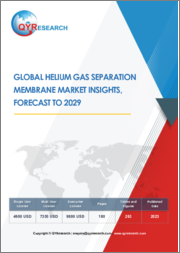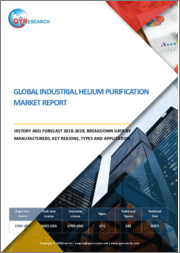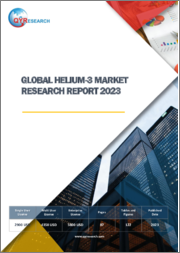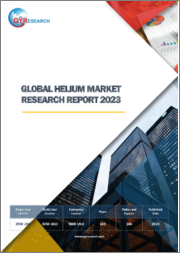
|
시장보고서
상품코드
1344327
헬륨 시장 : 단계별, 용도별, 최종 이용 산업별 - 세계 기회 분석 및 산업 예측(2023-2032년)Helium Market By Phase Type, By Application, By End-Use Industry : Global Opportunity Analysis and Industry Forecast, 2023-2032 |
||||||
헬륨 시장은 2022년 33억 달러로 평가되며 2023년부터 2032년까지 CAGR 4.2%로 성장하여 2032년에는 49억 달러에 달할 것으로 추정됩니다.
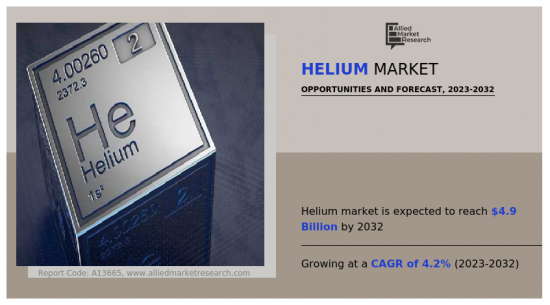
헬륨은 다양한 용도에 활용 가치가 있는 몇 가지 독특한 특성을 가지고 있습니다. 원소 중 끓는점이 가장 낮기 때문에 극저온에서도 기체 상태를 유지할 수 있습니다. 공기보다 가볍기 때문에 상승과 부양이 가능하여 풍선이나 비행선을 채우는 데 이상적입니다.
헬륨은 과학 연구와 실험에 많이 응용되고 있습니다. 끓는점이 낮고 불활성이기 때문에 극저온 공학에서 매우 중요한 냉각제로서 초전도, 양자 역학 등 다양한 연구에 필요한 극저온을 구현할 수 있습니다. 헬륨은 화학 및 생물학 분야에서 복잡한 혼합물의 분석 및 분리에 사용되는 과학적 방법인 가스 크로마토그래피에 응용되고 있습니다.
헬륨은 의료 및 헬스케어 분야에서도 중요한 역할을 합니다. 천식, 만성폐쇄성폐질환(COPD) 등 호흡기 질환 치료에 사용되는 호흡용 가스로서 헬륨은 종종 산소와 함께 사용됩니다. 헬륨은 밀도가 낮기 때문에 기도 저항이 낮아 환자가 더 쉽게 호흡할 수 있습니다. 헬륨은 자기공명영상장치(MRI)의 초전도 자석을 냉각하는 데도 사용됩니다.
헬륨의 가장 유명한 용도 중 하나는 풍선과 비행선에 헬륨을 채우는 것입니다. 헬륨은 공기보다 가볍기 때문에 풍선은 쉽게 하늘을 떠다닐 수 있습니다. 헬륨의 풍선에 대한 사용은 조사 목적뿐만 아니라 기상 연구, 항공 사진 촬영, 고공 관측 및 데이터 수집이 필요한 과학 실험에도 적용되고 있습니다. 헬륨의 독특한 특성은 양자 물리학의 발견과 초전도 및 MRI 스캔과 같은 첨단 기술 개발을 가능하게 하는 등 과학 연구의 획기적인 발전에 기여하고 있습니다.
상 유형별로는 액체 부문이 2022년 헬륨 시장에서 가장 빠르게 성장하는 부문입니다. 액체 헬륨은 극저온에 도달할 수 있는 탁월한 능력으로 인해 극저온 냉각제로 널리 사용되고 있습니다. 끓는점은 섭씨 -268.93도(화씨 -452도)로 다양한 과학 연구 분야에서 극저온 상태를 유지하는 데 이상적인 선택입니다. 특히 초전도, 저온 물리학, 재료 과학 등의 분야에서 중요한 역할을 합니다. 액체 헬륨은 MRI 장비, 입자 가속기 등 첨단 기술의 핵심 부품인 초전도 자석을 냉각하는 데 필수적입니다.
용도별로는 2022년 헬륨 시장에서 가장 빠르게 성장하는 분야는 호흡용 혼합물 분야입니다. 헬륨을 포함한 호흡 혼합물은 심해 다이빙 및 항공우주 활동과 같은 특정 특수 용도에 일반적으로 사용됩니다. 호흡용 혼합 가스에 헬륨을 첨가하면 가스의 특성에 따라 특정 목적을 달성할 수 있습니다. 헬륨은 종종 산소와 혼합되어 심해 다이빙에 사용되는 헬리옥스라는 호흡 혼합 가스를 만듭니다. 깊은 수심에서 다이빙을 할 때 압력이 높아지면 '심해의 환희'라고도 불리는 질소 중독을 일으킬 수 있습니다. 이를 방지하기 위해 호흡용 혼합기체의 질소 일부 또는 전부를 헬륨으로 대체합니다. 헬륨은 질소보다 밀도가 낮고 열전도율이 높기 때문에 극한의 수심에서도 안전하게 사용할 수 있습니다.
최종 사용 산업별로는 자동차, 금속 가공 및 기타를 포함한 기타 부문이 2022년 헬륨 시장에서 가장 빠르게 성장하는 부문입니다. 헬륨으로 채워진 타이어는 경량화, 연비 향상, 열 확산 개선 등의 이점을 제공합니다. 또한 헬륨은 가스 텅스텐 아크 용접(GTAW) 및 텅스텐 인산가스(TIG) 용접과 같은 특정 용접 방법에서 차폐 가스로도 활용될 수 있습니다. 이러한 기술에서는 헬륨을 아르곤과 같은 다른 가스와 결합하여 용접 아크 주변에 바람직한 보호 환경을 조성합니다. 헬륨을 도입함으로써 이러한 공정은 아크 안정성을 개선하고 열 전달을 증가시키며 용접 중 금속 산화를 방지할 수 있습니다.
지역별로는 아시아태평양이 2022년 헬륨 시장에서 가장 빠르게 성장하는 지역입니다. 아시아태평양은 극저온 및 초전도 분야 연구개발의 주요 거점입니다. 헬륨은 초전도 자석, MRI 장비, 입자 가속기, NMR 분광기 등 다양한 응용 분야에서 극저온 냉각제로서 중요한 역할을 하고 있습니다. 이러한 기술은 과학 연구, 건강 관리 및 재료 과학에 중요한 의미를 가지고 있습니다.
목차
제1장 서론
제2장 주요 요약
제3장 시장 개요
- 시장 정의와 범위
- 주요 조사 결과
- 영향요인
- 주요 투자 기회
- Porter's Five Forces 분석
- 공급 기업의 높은 교섭력
- 신규 참여업체의 위협이 높은
- 대체품의 위협이 중정도
- 경쟁강도는 중정도
- 구매자의 교섭력은 중정도
- 시장 역학
- 성장 촉진요인
- 헬륨에 관한 기술 진보
- 헬스케어 분야에서의 헬륨 수요 증가
- 성장 억제요인
- 헬륨 매장량 한계
- 기회
- 헬륨 재활용과 보전
- 성장 촉진요인
- COVID-19의 시장에 대한 영향 분석
- 가격 분석
- 밸류체인 분석
- 주요 규제 분석
제4장 헬륨 시장 : 단계 유형별
- 개요
- 액체
- 기체
제5장 헬륨 시장 : 용도별
- 개요
- 극저온
- 가압 및 퍼지
- 용접
- 제어 대기
- 리크 감지
- 브리징미크스챠
- 기타
제6장 헬륨 시장 : 최종 이용 산업별
- 개요
- 항공우주·방위
- 의료·헬스케어
- 전기·전자
- 기타
제7장 헬륨 시장 : 지역별
- 개요
- 북미
- 미국
- 캐나다
- 멕시코
- 유럽
- 독일
- 프랑스
- 이탈리아
- 스페인
- 영국
- 기타 유럽
- 아시아태평양
- 중국
- 일본
- 인도
- 한국
- 기타 아시아태평양
- 라틴아메리카, 중동 및 아프리카
- 브라질
- 사우디아라비아
- 남아프리카공화국
- 기타 지역
제8장 경쟁 상황
- 서론
- 주요 성공 전략
- 주요 10개 기업의 제품 매핑
- 경쟁 대시보드
- 경쟁 히트맵
- 주요 기업의 포지셔닝, 2022년
제9장 기업 개요
- Air Products & Chemicals Inc.
- Linde plc
- Praxair, Inc.
- Air Liquide S.A.
- Gazprom PJSC
- ExxonMobil Corporation
- Gulf Cryo S.A.L.
- IACX Energy
- Matheson Tri-Gas, Inc.
- Taiyo Nippon Sanso Corporation
According to a new report published by Allied Market Research, titled, "Helium Market," The helium market was valued at $3.3 billion in 2022, and is estimated to reach $4.9 billion by 2032, growing at a CAGR of 4.2% from 2023 to 2032.

Helium possesses several unique properties that make it valuable for various applications. It has the lowest boiling point of any element, which allows it to remain in a gaseous state at extremely low temperatures. It is lighter than air, which enables it to rise and float, making it ideal for filling balloons and airships.
Helium has numerous applications in scientific research and experimentation. Its low boiling point and inert nature make it a crucial coolant in cryogenics, enabling scientists to achieve extremely low temperatures required for various studies, such as superconductivity and quantum mechanics. Helium finds application in gas chromatography, a scientific method utilized for the analysis and separation of intricate mixtures in the fields of chemistry and biology.
Helium plays a vital role in medical and healthcare applications. As a breathing gas used to treat respiratory conditions such as asthma and chronic obstructive pulmonary disease (COPD), helium is frequently combined with oxygen. Helium's low density lowers airway resistance and makes it easier for patients to breathe. Helium is also used to cool the superconducting magnets in magnetic resonance imaging (MRI) scanners.
One of the most well-known uses of helium is in filling balloons and airships. Due to its lighter-than-air property, helium enables balloons to float effortlessly in the sky. The use of helium in balloons is not limited to recreational purposes but also extends to meteorological research, aerial photography, and scientific experiments that require elevated observations or data collection. Helium's unique properties contribute to breakthroughs in scientific research, including discoveries in quantum physics and enabling the development of advanced technologies such as superconductivity and MRI scanning.
On the basis of phase type, the liquid segment is the fastest-growing segment of the helium market in 2022. Liquid helium is a widely utilized cryogenic coolant due to its exceptional ability to reach incredibly low temperatures. With a boiling point of -268.93 degrees Celsius (-452 degrees Fahrenheit), it is an ideal choice for maintaining extreme cold conditions in various scientific research applications. Specifically, it plays a crucial role in fields like superconductivity, low-temperature physics, and materials science. Liquid helium is indispensable for cooling superconducting magnets, which are integral components in advanced technologies such as MRI machines and particle accelerators.
On the basis of application, the breathing mixture segment is the fastest-growing segment of the helium market in 2022. Breathing mixtures that include helium are commonly used in certain specialized applications, such as deep-sea diving and aerospace activities. The addition of helium to breathing mixtures serves specific purposes based on the properties of the gas. Helium is often mixed with oxygen to create a breathing mixture called heliox, which is used in deep-sea diving. When diving at great depths, the increased pressure can cause a condition called nitrogen narcosis, also known as "rapture of the deep." To counteract this, helium is used to replace some or all of the nitrogen in the breathing mixture. Helium has a lower density and higher thermal conductivity than nitrogen, making it safer to use at extreme depths.
On the basis of the end-use industry, the others including automotive, metal fabrication, and others segment is the fastest-growing segment of the helium market in 2022. Helium-filled tires can provide advantages such as decreased weight, enhanced fuel efficiency, and improved heat dispersion. Moreover, helium finds application as a shielding gas in specific welding methods like gas tungsten arc welding (GTAW) or tungsten inert gas (TIG) welding. In these techniques, helium is combined with other gases, such as argon, to generate the desired protective environment around the welding arc. By incorporating helium, these processes achieve enhanced arc stability, elevated heat transfer, and prevention of metal oxidation during welding.
By region, the Asia-Pacific is the fastest-growing region of the helium market in 2022. The Asia-Pacific region is a leading hub for research and development in the field of cryogenics and superconductivity. Helium plays a crucial role as a cryogenic coolant in a wide range of applications such as superconducting magnets, MRI machines, particle accelerators, and NMR spectrometers. These technologies have significant implications for scientific research, healthcare, and materials science.
- In January 2021, the Lingang Economic District in China chose Fives Group to supply 13 Cryomec cryogenic centrifugal pumps for their upcoming air separation unit (ASU). The ASU is specifically designed to generate more than 2,000 tons of oxygen per day, highlighting the importance of cryogenics in large-scale industrial processes.
- The major players operating in the global helium market include Air Liquide S.A., Air Products & Chemicals Inc., ExxonMobil Corporation, Gazprom PJSC, Gulf Cryo S.A.L., IACX Energy, Linde plc, Matheson Tri-Gas, Inc., Praxair, Inc., and Taiyo Nippon Sanso Corporation.
Key Benefits For Stakeholders
- This report provides a quantitative analysis of the market segments, current trends, estimations, and dynamics of the helium market analysis from 2022 to 2032 to identify the prevailing helium market opportunities.
- The market research is offered along with information related to key drivers, restraints, and opportunities.
- Porter's five forces analysis highlights the potency of buyers and suppliers to enable stakeholders make profit-oriented business decisions and strengthen their supplier-buyer network.
- In-depth analysis of the helium market segmentation assists to determine the prevailing market opportunities.
- Major countries in each region are mapped according to their revenue contribution to the global market.
- Market player positioning facilitates benchmarking and provides a clear understanding of the present position of the market players.
- The report includes the analysis of the regional as well as global helium market trends, key players, market segments, application areas, and market growth strategies.
Key Market Segments
By Application
- Cryogenics
- Pressurizing and Purging
- Welding
- Controlled Atmosphere
- Leak Detection
- Breathing Mixture
- Others
By End-Use Industry
- Aerospace and Defense
- Medical and Healthcare
- Electricals and Electronics
- Others
By Phase Type
- Liquid
- Gaseous
By Region
- North America
- U.S.
- Canada
- Mexico
- Europe
- Germany
- France
- Italy
- Spain
- UK
- Rest of Europe
- Asia-Pacific
- China
- Japan
- India
- South Korea
- Rest of Asia-Pacific
- LAMEA
- Brazil
- Saudi Arabia
- South Africa
- Rest of LAMEA
Key Market Players:
- Air Liquide S.A.
- Air Products & Chemicals Inc.
- ExxonMobil Corporation
- Gazprom PJSC
- Gulf Cryo S.A.L.
- IACX Energy
- Linde plc
- Matheson Tri-Gas, Inc.
- Praxair, Inc.
- Taiyo Nippon Sanso Corporation
TABLE OF CONTENTS
CHAPTER 1: INTRODUCTION
- 1.1. Report description
- 1.2. Key market segments
- 1.3. Key benefits to the stakeholders
- 1.4. Research Methodology
- 1.4.1. Primary research
- 1.4.2. Secondary research
- 1.4.3. Analyst tools and models
CHAPTER 2: EXECUTIVE SUMMARY
- 2.1. CXO Perspective
CHAPTER 3: MARKET OVERVIEW
- 3.1. Market definition and scope
- 3.2. Key findings
- 3.2.1. Top impacting factors
- 3.2.2. Top investment pockets
- 3.3. Porter's five forces analysis
- 3.3.1. High bargaining power of suppliers
- 3.3.2. High threat of new entrants
- 3.3.3. Moderate threat of substitutes
- 3.3.4. Moderate intensity of rivalry
- 3.3.5. Moderate bargaining power of buyers
- 3.4. Market dynamics
- 3.4.1. Drivers
- 3.4.1.1. Advancements in technology with respect to helium
- 3.4.1.2. Rise in demand for helium in the healthcare sector
- 3.4.1. Drivers
- 3.4.2. Restraints
- 3.4.2.1. Limited helium reserves
- 3.4.3. Opportunities
- 3.4.3.1. Helium recycling and conservation
- 3.5. COVID-19 Impact Analysis on the market
- 3.6. Pricing Analysis
- 3.7. Value Chain Analysis
- 3.8. Key Regulation Analysis
CHAPTER 4: HELIUM MARKET, BY PHASE TYPE
- 4.1. Overview
- 4.1.1. Market size and forecast
- 4.2. Liquid
- 4.2.1. Key market trends, growth factors and opportunities
- 4.2.2. Market size and forecast, by region
- 4.2.3. Market share analysis by country
- 4.3. Gaseous
- 4.3.1. Key market trends, growth factors and opportunities
- 4.3.2. Market size and forecast, by region
- 4.3.3. Market share analysis by country
CHAPTER 5: HELIUM MARKET, BY APPLICATION
- 5.1. Overview
- 5.1.1. Market size and forecast
- 5.2. Cryogenics
- 5.2.1. Key market trends, growth factors and opportunities
- 5.2.2. Market size and forecast, by region
- 5.2.3. Market share analysis by country
- 5.3. Pressurizing and Purging
- 5.3.1. Key market trends, growth factors and opportunities
- 5.3.2. Market size and forecast, by region
- 5.3.3. Market share analysis by country
- 5.4. Welding
- 5.4.1. Key market trends, growth factors and opportunities
- 5.4.2. Market size and forecast, by region
- 5.4.3. Market share analysis by country
- 5.5. Controlled Atmosphere
- 5.5.1. Key market trends, growth factors and opportunities
- 5.5.2. Market size and forecast, by region
- 5.5.3. Market share analysis by country
- 5.6. Leak Detection
- 5.6.1. Key market trends, growth factors and opportunities
- 5.6.2. Market size and forecast, by region
- 5.6.3. Market share analysis by country
- 5.7. Breathing Mixture
- 5.7.1. Key market trends, growth factors and opportunities
- 5.7.2. Market size and forecast, by region
- 5.7.3. Market share analysis by country
- 5.8. Others
- 5.8.1. Key market trends, growth factors and opportunities
- 5.8.2. Market size and forecast, by region
- 5.8.3. Market share analysis by country
CHAPTER 6: HELIUM MARKET, BY END-USE INDUSTRY
- 6.1. Overview
- 6.1.1. Market size and forecast
- 6.2. Aerospace and Defense
- 6.2.1. Key market trends, growth factors and opportunities
- 6.2.2. Market size and forecast, by region
- 6.2.3. Market share analysis by country
- 6.3. Medical and Healthcare
- 6.3.1. Key market trends, growth factors and opportunities
- 6.3.2. Market size and forecast, by region
- 6.3.3. Market share analysis by country
- 6.4. Electricals and Electronics
- 6.4.1. Key market trends, growth factors and opportunities
- 6.4.2. Market size and forecast, by region
- 6.4.3. Market share analysis by country
- 6.5. Others
- 6.5.1. Key market trends, growth factors and opportunities
- 6.5.2. Market size and forecast, by region
- 6.5.3. Market share analysis by country
CHAPTER 7: HELIUM MARKET, BY REGION
- 7.1. Overview
- 7.1.1. Market size and forecast By Region
- 7.2. North America
- 7.2.1. Key trends and opportunities
- 7.2.2. Market size and forecast, by Phase Type
- 7.2.3. Market size and forecast, by Application
- 7.2.4. Market size and forecast, by End-Use Industry
- 7.2.5. Market size and forecast, by country
- 7.2.5.1. U.S.
- 7.2.5.1.1. Key market trends, growth factors and opportunities
- 7.2.5.1.2. Market size and forecast, by Phase Type
- 7.2.5.1.3. Market size and forecast, by Application
- 7.2.5.1.4. Market size and forecast, by End-Use Industry
- 7.2.5.2. Canada
- 7.2.5.2.1. Key market trends, growth factors and opportunities
- 7.2.5.2.2. Market size and forecast, by Phase Type
- 7.2.5.2.3. Market size and forecast, by Application
- 7.2.5.2.4. Market size and forecast, by End-Use Industry
- 7.2.5.3. Mexico
- 7.2.5.3.1. Key market trends, growth factors and opportunities
- 7.2.5.3.2. Market size and forecast, by Phase Type
- 7.2.5.3.3. Market size and forecast, by Application
- 7.2.5.3.4. Market size and forecast, by End-Use Industry
- 7.3. Europe
- 7.3.1. Key trends and opportunities
- 7.3.2. Market size and forecast, by Phase Type
- 7.3.3. Market size and forecast, by Application
- 7.3.4. Market size and forecast, by End-Use Industry
- 7.3.5. Market size and forecast, by country
- 7.3.5.1. Germany
- 7.3.5.1.1. Key market trends, growth factors and opportunities
- 7.3.5.1.2. Market size and forecast, by Phase Type
- 7.3.5.1.3. Market size and forecast, by Application
- 7.3.5.1.4. Market size and forecast, by End-Use Industry
- 7.3.5.2. France
- 7.3.5.2.1. Key market trends, growth factors and opportunities
- 7.3.5.2.2. Market size and forecast, by Phase Type
- 7.3.5.2.3. Market size and forecast, by Application
- 7.3.5.2.4. Market size and forecast, by End-Use Industry
- 7.3.5.3. Italy
- 7.3.5.3.1. Key market trends, growth factors and opportunities
- 7.3.5.3.2. Market size and forecast, by Phase Type
- 7.3.5.3.3. Market size and forecast, by Application
- 7.3.5.3.4. Market size and forecast, by End-Use Industry
- 7.3.5.4. Spain
- 7.3.5.4.1. Key market trends, growth factors and opportunities
- 7.3.5.4.2. Market size and forecast, by Phase Type
- 7.3.5.4.3. Market size and forecast, by Application
- 7.3.5.4.4. Market size and forecast, by End-Use Industry
- 7.3.5.5. UK
- 7.3.5.5.1. Key market trends, growth factors and opportunities
- 7.3.5.5.2. Market size and forecast, by Phase Type
- 7.3.5.5.3. Market size and forecast, by Application
- 7.3.5.5.4. Market size and forecast, by End-Use Industry
- 7.3.5.6. Rest of Europe
- 7.3.5.6.1. Key market trends, growth factors and opportunities
- 7.3.5.6.2. Market size and forecast, by Phase Type
- 7.3.5.6.3. Market size and forecast, by Application
- 7.3.5.6.4. Market size and forecast, by End-Use Industry
- 7.4. Asia-Pacific
- 7.4.1. Key trends and opportunities
- 7.4.2. Market size and forecast, by Phase Type
- 7.4.3. Market size and forecast, by Application
- 7.4.4. Market size and forecast, by End-Use Industry
- 7.4.5. Market size and forecast, by country
- 7.4.5.1. China
- 7.4.5.1.1. Key market trends, growth factors and opportunities
- 7.4.5.1.2. Market size and forecast, by Phase Type
- 7.4.5.1.3. Market size and forecast, by Application
- 7.4.5.1.4. Market size and forecast, by End-Use Industry
- 7.4.5.2. Japan
- 7.4.5.2.1. Key market trends, growth factors and opportunities
- 7.4.5.2.2. Market size and forecast, by Phase Type
- 7.4.5.2.3. Market size and forecast, by Application
- 7.4.5.2.4. Market size and forecast, by End-Use Industry
- 7.4.5.3. India
- 7.4.5.3.1. Key market trends, growth factors and opportunities
- 7.4.5.3.2. Market size and forecast, by Phase Type
- 7.4.5.3.3. Market size and forecast, by Application
- 7.4.5.3.4. Market size and forecast, by End-Use Industry
- 7.4.5.4. South Korea
- 7.4.5.4.1. Key market trends, growth factors and opportunities
- 7.4.5.4.2. Market size and forecast, by Phase Type
- 7.4.5.4.3. Market size and forecast, by Application
- 7.4.5.4.4. Market size and forecast, by End-Use Industry
- 7.4.5.5. Rest of Asia-Pacific
- 7.4.5.5.1. Key market trends, growth factors and opportunities
- 7.4.5.5.2. Market size and forecast, by Phase Type
- 7.4.5.5.3. Market size and forecast, by Application
- 7.4.5.5.4. Market size and forecast, by End-Use Industry
- 7.5. LAMEA
- 7.5.1. Key trends and opportunities
- 7.5.2. Market size and forecast, by Phase Type
- 7.5.3. Market size and forecast, by Application
- 7.5.4. Market size and forecast, by End-Use Industry
- 7.5.5. Market size and forecast, by country
- 7.5.5.1. Brazil
- 7.5.5.1.1. Key market trends, growth factors and opportunities
- 7.5.5.1.2. Market size and forecast, by Phase Type
- 7.5.5.1.3. Market size and forecast, by Application
- 7.5.5.1.4. Market size and forecast, by End-Use Industry
- 7.5.5.2. Saudi Arabia
- 7.5.5.2.1. Key market trends, growth factors and opportunities
- 7.5.5.2.2. Market size and forecast, by Phase Type
- 7.5.5.2.3. Market size and forecast, by Application
- 7.5.5.2.4. Market size and forecast, by End-Use Industry
- 7.5.5.3. South Africa
- 7.5.5.3.1. Key market trends, growth factors and opportunities
- 7.5.5.3.2. Market size and forecast, by Phase Type
- 7.5.5.3.3. Market size and forecast, by Application
- 7.5.5.3.4. Market size and forecast, by End-Use Industry
- 7.5.5.4. Rest of LAMEA
- 7.5.5.4.1. Key market trends, growth factors and opportunities
- 7.5.5.4.2. Market size and forecast, by Phase Type
- 7.5.5.4.3. Market size and forecast, by Application
- 7.5.5.4.4. Market size and forecast, by End-Use Industry
CHAPTER 8: COMPETITIVE LANDSCAPE
- 8.1. Introduction
- 8.2. Top winning strategies
- 8.3. Product Mapping of Top 10 Player
- 8.4. Competitive Dashboard
- 8.5. Competitive Heatmap
- 8.6. Top player positioning, 2022
CHAPTER 9: COMPANY PROFILES
- 9.1. Air Products & Chemicals Inc.
- 9.1.1. Company overview
- 9.1.2. Key Executives
- 9.1.3. Company snapshot
- 9.1.4. Operating business segments
- 9.1.5. Product portfolio
- 9.1.6. Business performance
- 9.2. Linde plc
- 9.2.1. Company overview
- 9.2.2. Key Executives
- 9.2.3. Company snapshot
- 9.2.4. Operating business segments
- 9.2.5. Product portfolio
- 9.2.6. Business performance
- 9.3. Praxair, Inc.
- 9.3.1. Company overview
- 9.3.2. Key Executives
- 9.3.3. Company snapshot
- 9.3.4. Operating business segments
- 9.3.5. Product portfolio
- 9.4. Air Liquide S.A.
- 9.4.1. Company overview
- 9.4.2. Key Executives
- 9.4.3. Company snapshot
- 9.4.4. Operating business segments
- 9.4.5. Product portfolio
- 9.4.6. Business performance
- 9.4.7. Key strategic moves and developments
- 9.5. Gazprom PJSC
- 9.5.1. Company overview
- 9.5.2. Key Executives
- 9.5.3. Company snapshot
- 9.5.4. Operating business segments
- 9.5.5. Product portfolio
- 9.5.6. Business performance
- 9.5.7. Key strategic moves and developments
- 9.6. ExxonMobil Corporation
- 9.6.1. Company overview
- 9.6.2. Key Executives
- 9.6.3. Company snapshot
- 9.6.4. Operating business segments
- 9.6.5. Product portfolio
- 9.6.6. Business performance
- 9.7. Gulf Cryo S.A.L.
- 9.7.1. Company overview
- 9.7.2. Key Executives
- 9.7.3. Company snapshot
- 9.7.4. Operating business segments
- 9.7.5. Product portfolio
- 9.8. IACX Energy
- 9.8.1. Company overview
- 9.8.2. Key Executives
- 9.8.3. Company snapshot
- 9.8.4. Operating business segments
- 9.8.5. Product portfolio
- 9.9. Matheson Tri-Gas, Inc.
- 9.9.1. Company overview
- 9.9.2. Key Executives
- 9.9.3. Company snapshot
- 9.9.4. Operating business segments
- 9.9.5. Product portfolio
- 9.10. Taiyo Nippon Sanso Corporation
- 9.10.1. Company overview
- 9.10.2. Key Executives
- 9.10.3. Company snapshot
- 9.10.4. Operating business segments
- 9.10.5. Product portfolio






